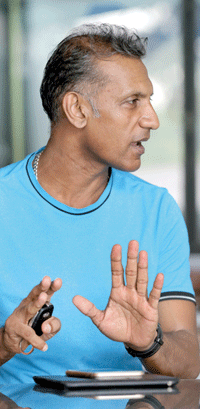A little bit of catching practice with Ruwan Kalpage
View(s):The post-match discussion by Indian experts led by doyen Sunil Gavaskar hit us like a sock-in-the-jaw. They were of the opinion that the Lankans played below-par cricket during that lost series. One particular area that came in for heavy criticism was Sri Lanka’s fielding. At one point Gavaskar said that in the first Test, the Lankans could have wrested the initiative if they held on to the catches offered, but once they were unhooked, the Indian machine just overhauled the home team with no stress at all. Finally, Gavaskar queried if this series could be even called a Test series, because the Indians were not tested at all.

Kalpage who now runs his own cricket academy may have better fielders in his camp than those who drop at top level - Pic by Sameera Weerasekara
Internationally, this is serious stuff. Expert opinions of this calibre make a huge impact on the game and may be, its impact will reach us a while later.
Talking of fielding, the name that rings a bell in the Lankan game is Ruwan Kalpage. Until 2014, he was part and parcel of this set up and his contribution to it was mostly by shaping up our game in fielding. So much so, there was a time the Lankan team was hailed for its fielding, and the achievements also went almost hand-in-hand.
The Kalpage clan are no strangers to Lankan sport – especially cricket. If I remember right, Sena Kalpage opened bowling for Nalanda in the early sixties, and he even made a tour of Australia with the Lankan schools side at that time. Thirty years later, his son Ruwan, who shone as an off-spinner for St. Anthony’s Katugastota, made his Test debut against India, under Arjuna Ranatunga — in 1993.
Though he was originally picked as a useful off-spinner who could also score few runs with the bat in the late order, he also caught the eye of the then selectors, as a man who could hold on to a catch.
Then, in 1999, straight after he retired from the senior game, Trevor Chappell took Kalpage under his wings and there he began a journey that still progresses through the talents of two countries – Sri Lanka and Bangladesh. Even in Bangladesh, Ruwan was largely responsible for the elevation of the standard of fielding, till he suddenly decided to call it a day, last year.
Yet, at this end, the Musings felt we could talk to Ruwan on what really the art of fielding is and go through the motions of what it was, how it is now, how it should be and what it could be. Tough asking – but it is something worth discussing.
Ruwan explained: “A basic rule in serious cricket is – ‘you cannot hide a player’ — be it Test Cricket, Limited-Overs Cricket or T-20 Cricket. I have always found that, the moment you cease to enjoy fielding, the ball will start looking for you. So, it is our business, as players, to identify players and train them to occupy certain positions they are comfortable with. This is not rocket science; you must get the players to start feeling comfortable. When they are comfortable, they respond by settling in their allotted fielding positions.
“For instance, your can quantify batting and bowling. You can decide to play seven batters and four bowlers. But, you cannot quantify the fielding slots; they come within the playing XI. Then it is easy. Let’s not forget how important the segment of fielding is. Sometimes winning or losing the game would depend upon a catch that you missed, a run-out opportunity you threw astray or a mere misfield. Any of these things may change the day. May finish a certain player’s career or, even the outcome of a series might hang on one of these opportunities. So, fielding is as important as any other segment of the game. As far as I am concerned, I have always enjoyed my cricket as a player and then, when I changed my hat and became a coach, I began to teach others how they could enjoy fielding.”
Recalling his playing days, Kalpage, one-time National Assistant Coach, said that during his time players such as Aravinda de Silva, Roshan Mahanama and Hashan Tillekeratne occupied special slots.
“Then, just before my era, we had players such as Roy Dias and Don Arunasiri who were good. Later on, there were players such as Sanath Jayasuriya, Muttiah Muralitharan and T.M. Dilshan.
“In a side, you needn’t have eleven superstars. When you have players in the above calibre, you can have them scouting the vulnerable points. In reality, there are only about 4 or 5 players who are specialists and man important points. For instance, Dilshan covered the slot of cover point till he decided to call it a day. Even at that point, he was an extraordinary fielder. Not only that, in the slog overs, he used to move from point and man the boundary and believe me, he did it voluntarily. Now, to replace a person of that nature takes a beating. But sadly, what is happening now is something else. I remember when I was working with Marvan Atapattu, who was head coach, we had identified some players whose fielding was suspect, in spite of them being good in other disciplines. Yet, soon after Atapattu and I had moved on, those players were in the National XI.”
Kalpage was of the opinion that some of those players were not quite ready to move to the real international stage. He pointed out that, in Sri Lanka, we have the process of going through the stages – development, the ‘A’ team and then the proper national team. Sometimes, if a player is not quite ready to move on to the next stage, it might put pressure on the others.
“When I was handling the Lankan team, I always wanted to go with the players with the right criteria. Go for the best you have. If you do not have the right talent at hand, go for the under nineteen level – sometimes there may be someone who could fit the bill but, the inclusion must be ticked off at the right cages. I remember when we were there, Kusal Mendis, as a young player, was training with the national team – and it paid off – we always wanted to have a benchmark”. Kalpage said. “Even when coaching the Bangladesh side with head coach Chandika Hathurusinghe, we worked in the same fashion.”
 However, he said, he was watching the last series and he noticed that some players did not move about with the need of the moment, like Dishan did at that time. “At that moment, Dilshan thought and believed that it was his duty to man these points with diligence. But sadly, it was not happening during the last Test series. We all admit that people do make mistakes, but, it is our job to minimise them. To do that, you have to pick the right people to occupy the right slots, and I reiterate, they must like what they are doing. They must enjoy the part of fielding too. Yet sadly, I cannot see in this present lot, people manning the correct slots in their fielding positions. We all admit there will be injuries and setbacks but, it is up to the administration to be ready with the right combination – the players, the coach and that whole gamut should work as one unit to achieve that.”
However, he said, he was watching the last series and he noticed that some players did not move about with the need of the moment, like Dishan did at that time. “At that moment, Dilshan thought and believed that it was his duty to man these points with diligence. But sadly, it was not happening during the last Test series. We all admit that people do make mistakes, but, it is our job to minimise them. To do that, you have to pick the right people to occupy the right slots, and I reiterate, they must like what they are doing. They must enjoy the part of fielding too. Yet sadly, I cannot see in this present lot, people manning the correct slots in their fielding positions. We all admit there will be injuries and setbacks but, it is up to the administration to be ready with the right combination – the players, the coach and that whole gamut should work as one unit to achieve that.”
Kalpage said he has worked with a lot of people who have manned the position of head coach. I have worked with Trevor Chappell, Tom Moody, Trevor Bayliss, Graham Ford, Paul Farbrace and Marvan Atapattu. Besides that, I worked with Chandika Hathurusinghe in Bangladesh. So, I have seen all that’s happening out there in the middle.


